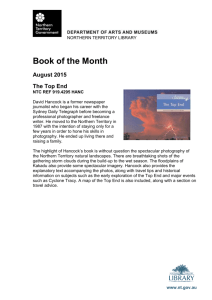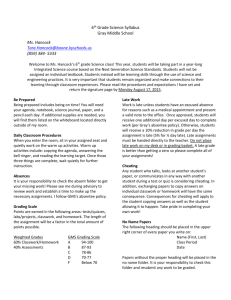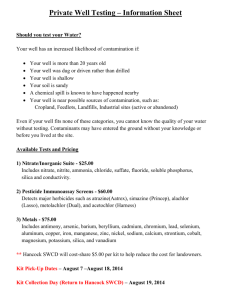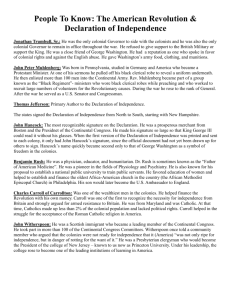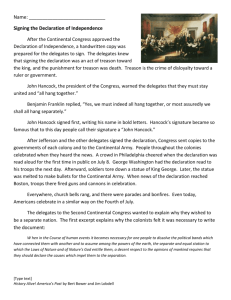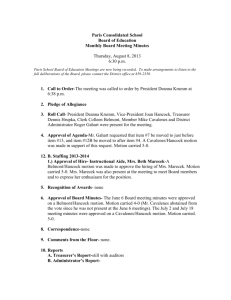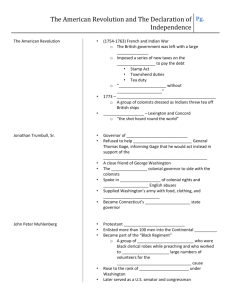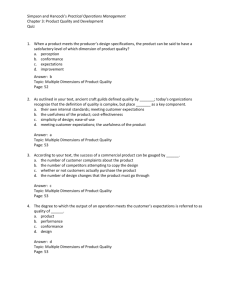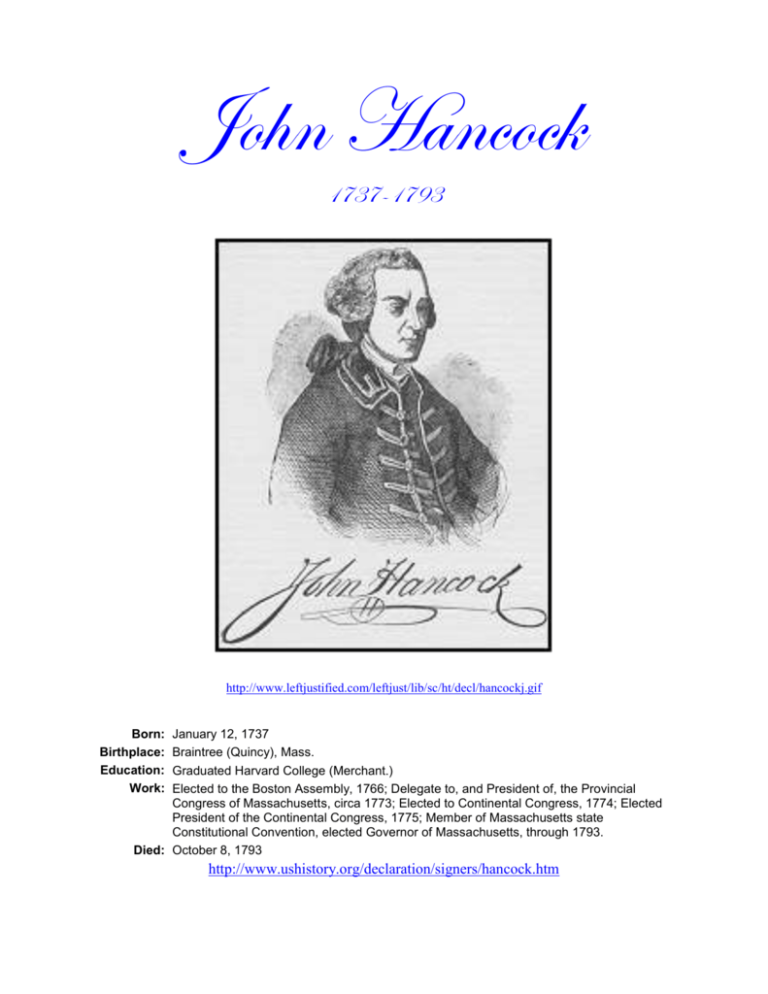
John Hancock
1737-1793
http://www.leftjustified.com/leftjust/lib/sc/ht/decl/hancockj.gif
Born:
Birthplace:
Education:
Work:
January 12, 1737
Braintree (Quincy), Mass.
Graduated Harvard College (Merchant.)
Elected to the Boston Assembly, 1766; Delegate to, and President of, the Provincial
Congress of Massachusetts, circa 1773; Elected to Continental Congress, 1774; Elected
President of the Continental Congress, 1775; Member of Massachusetts state
Constitutional Convention, elected Governor of Massachusetts, through 1793.
Died: October 8, 1793
http://www.ushistory.org/declaration/signers/hancock.htm
Table of Contents
I. Pictures of Hancock
II. Timeline of John Hancock’s life
III. Hancock’s involvement with Declaration of Independence
IV. Hancock’s involvement with the Boston Massacre
A. Includes Glorious Lessons Exhibit
V. Social Studies Standards
VI. Links for Students, including biographies
VII. Bibliography
Signing the Declaration of Independence
http://www.usconstitution.com/DeclarationofIndependence.htm
Danielle Demetreu
History 206
www.lineofbattle.org/ declar558.html
This is an engraving on John Hancock.
This is a letter from John Hancock
to George Washington informing him of
the Declaration.
http://www.loc.gov/exhibits/treasures/ima
ges/0900002.jpg
http://www.instoneinc.com/gallery/John_Hancock.jpg
John Hancock (1737-1793) signed the Declaration of Independence and was
a leader of the movement toward revolution in the American colonies. Later
prominent in the Continental Congress, he was elected Massachusetts
governor for nine terms.
On the character of John Hancock, he was a very honorable man, and although
he was very wealthy, he avoided excess indulgence. His habits were very
virtuous, and was kind and courteous. He did not think he was superior and
was not arrogant because of his wealth.
1760- Hancock was an apprentice to his uncle as a clerk. He proved to be so
honest that he was sent on a business mission to England. There he got involved
with some of the leading businessmen of London.
1763- Hancock’s uncle died, and he inherited the business and became very
wealthy.
Soon after, he became very involved in revolutionary politics and a big advocator
for independence from Great Britain. He was involved with John and Sam Adams
and other leaders in the republican movement in New England.
1766- He was elected to the Boston Assembly and was a member of the Stamp
Act Congress.
1768- His business was impounded by customs officials at Boston Harbor on a
charge of smuggled goods. A riot occurred, stormed the customs post, burned
the government boat, and beat the officers.
1773- John Hancock supported the Boston Tea Party.
1774- Elected to the Provincial Congress of Massachusetts and the Continental
Congress.
1776- He became President of the Continental Congress when Peyton Randolph
resigned.
1777- Retired because of health problems, but continued to participate in
writing the Constitution. He was elected Governorship of the state, and
remained in office there until his death in 1793.
www.ushistory.org.declaration/signers/hancock.htm
". . . and to Declare them Free and Independent States . . . "
http://www.federalist.com/histdocs/decorig.jpg
“I write,” said Hancock as he signed the Declaration of Independence,
“so George III may read without his spectacles.” (Umbrieght)
A signature to the declaration of independence, without reference to general views, was, to
each individual, a personal consideration of most momentous import. It would be regarded in
England as treason, and expose any man to the halter or the block. In this work of treason,
John Hancock led the way, as president of the congress, and by the force with which he wrote,
he seems to have determined that his name should never be erased.
http://www.colonialhall.com/hancock/hancock2.php
The Boston Massacre
John Hancock was also
involved in what was called the
"Boston Massacre" (1770), which
was really not a massacre in the
sense that a lot of people were
slaughtered (because only five
people were killed), it was a
massacre in the sense that the
British government's authority was
not going to be tolerated. This
incident marked the beginning of the end for England and its presence in the
United States of America.
(http://campus.northpark.edu/history/WebChron/USA/BostonMassacre.html)
After this fight, the bodies of the slain were buried with suitable
demonstrations of public grief. In commemoration of the event, John Hancock
was appointed to deliver an address. He spoke of independence and against
tyranny. The speech showed his enormous patriotism for the colonies.
See a written account of his speech here:
http://www.colonialhall.com/hancock/hancock4.php
In the Glorious Lessons exhibit at St. Bonaventure University, there
are a few artifacts that go along with John Hancock. The first one is #17, the
Declaration of Independence of the United States of America. This particular
example of the Declaration is a steel engraving of Thomas Jefferson’s draft.
The second one is #19, which is also a reproduction of the Declaration of
Independence. This one looks more like the original because it is an
engraving on rice paper. There is also a letter signed by John Hancock from
1776 in which he writes to the Assembly of Virginia regarding the support of
soldiers and sufficient bounty and land grants. All of these documents show
John Hancock’s famous signature. Showing these to the students would give
them a good hands-on approach to learning about John Hancock and the
Declaration of Independence. (Glorious Lessons Check List)
Standard 1
Social Studies
History of the United States
and New York
Students will: use a variety Key Idea 4: The skills of historical analysis include the
of intellectual skills to
demonstrate their
understanding of major ideas,
eras, themes, developments,
and turning points in the history
of the United States and New
York.
Elementary
ability to: explain the significance of historical evidence;
weigh the importance, reliability, and validity of evidence;
understand the concept of multiple causation; understand
the importance of changing and competing interpretations
of different historical developments.
Performance Indicators--Students will:
Intermediate
• consider different
• consider the sources of
interpretations of key
historic documents,
events and/or issues in
narratives, or artifacts and
history and understand the evaluate their reliability
differences in these
accounts
• understand how different
experiences, beliefs,
• explore different
values, traditions, and
experiences, beliefs,
motives cause individuals
motives, and traditions of
and groups to interpret
people living in their
historic events and issues
from different perspectives
neighborhoods,
communities, and State
• compare and contrast
• view historic events
different interpretations of
through the eyes of those
key events and issues in
who were there, as shown New York State and United
in their art, writings, music, States history and explain
and artifacts.
reasons for these different
accounts
• describe historic events
through the eyes and
experiences of those who
were there. (Taken from
National Standards for
History for Grades K-4)
Commencement
• analyze historical
narratives about key
events in New York State
and United States history
to identify the facts and
evaluate the authors’
perspectives
• consider different
historians’ analyses of the
same event or
development in United
States history to
understand how different
viewpoints and/or frames
of reference influence
historical interpretations
• evaluate the validity and
credibility of historical
interpretations of important
events or issues in New
York State or United States
history, revising these
interpretations as new
information is learned and
other interpretations are
developed. (Adapted from
National Standards for
United States History)
Copyright © 2000-2004 EduSolution.com All rights reserved. Last modified 11.23.04 12:05 am EST
http://www.edusolution.com/socialstudies/standards/standard1/keyidea4.htm
Links for Students:
http://www.americaslibrary.gov/cgibin/page.cgi/jb/colonial/hancock_1
This site is a fun one for students. It gives a short biography with
pictures, a timeline of colonial America, and asks questions for the
students to think about.
http://www.nationmaster.com/encyclopedia/John-Hancock
This is an encyclopedia entry about John Hancock. It gives dates
and his accomplishments. There are also links within the article
students can click on to learn more about specific things.
http://www.theamericanrevolution.org/ipeople/jhcock.asp
This is a very thorough biography of Hancock. Students can also
click on links on the side to get more information about the American
Revolution.
http://www.colonialhall.com/hancock/hancock2.php
Another thorough biography of John Hancock. Students can
compare this one with the one above. There are also more
biographies of men involved with the Revolutionary War to help them
fully understand.
Works Cited
Umbreit, Kenneth. Founding Fathers. New York: Harper & Brothers
Publishers, 1941.
Glorious Lessons: The Idea of America Exhibition Checklist. The
Regina A. Quick Center for the Arts, St. Bonaventure University.
September 24, 2004 – March 20, 2005
Vinci, John. 2004. “John Hancock.”
http://www.colonialhall.com/hancock/hancock.php
“Biography of John Hancock.”
http://www.bookrags.com/biography/john-hancock/
“Encyclopedia: John Hancock.”
http://www.nationmaster.com/encyclopedia/John_Hancock
“John Hancock.”
http://www.ushistory.org/declaration/signers/hancock.htm

